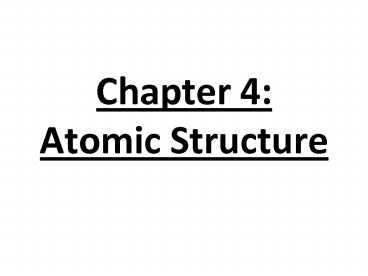Chapter 4: Atomic Structure - PowerPoint PPT Presentation
1 / 44
Title:
Chapter 4: Atomic Structure
Description:
Cathode ray tube passed electric current through gases at low pressure ... sell three varieties of apples: Granny Smith, Red Delicious, and Golden Delicious. ... – PowerPoint PPT presentation
Number of Views:462
Avg rating:3.0/5.0
Title: Chapter 4: Atomic Structure
1
Chapter 4 Atomic Structure
2
4.1 4.2 Defining the Atom - Structure of the
Atom
3
Atoms are composed of three subatomic particles
- Protons
- Neutrons
- Electrons
4
Democritus ??
5
(No Transcript)
6
Dalton??
7
(No Transcript)
8
Thomson???
9
http//highered.mcgraw-hill.com/sites/0072512644/s
tudent_view0/chapter2/animations_center.html http
//www.chem.uiuc.edu/clcwebsite/video/Cath.mov
10
Millikan??
11
http//highered.mcgraw-hill.com/sites/0072512644/s
tudent_view0/chapter2/animations_center.html
12
Goldstein??
13
(No Transcript)
14
Chadwick??
15
(No Transcript)
16
A neutron walked into a bar and asked for the
price of a drink. "For you," the bartender
replied "no charge."
17
To Summarize
18
The Atomic Nucleus
19
Thomsons Plum Pudding Model of the Atom
- electrons were stuck
- into a lump of
- positive charge,
- similar to raisins
- stuck in dough
20
Rutherford??
21
(No Transcript)
22
(No Transcript)
23
http//www.mhhe.com/physsci/chemistry/animations/c
hang_2e/rutherfords_experiment.swf
http//video.google.com/videoplay?docid-373655659
0151314279qrutherfordgoldfoilexperimenthlen
24
Plum Pudding vs. Rutherfords
25
Rutherfords Nuclear Atom
- the protons and neutrons are located in the
nucleus - The electrons are distributed around the nucleus
and occupy almost all the volume of the atom. - the nucleus is tiny compared with the atom as a
whole. - If an atom were the size of a football stadium,
the nucleus would be about the size of a marble.
26
(No Transcript)
27
Chapter 4.3 Distinguishing Among Atoms
- A grocery store might sell three varieties of
apples Granny Smith, Red Delicious, and Golden
Delicious. Apple varieties can differ in color,
size, texture, aroma, and taste. Just as apples
come in different varieties, a chemical element
can come in different varieties called
isotopes.
28
I. Atomic Numbers
29
Elements are different because they contain
different numbers of protons.
- The atomic number of an element is the number of
protons in the nucleus of an atom of that
element. - atoms are electrically neutral.
- the number of electrons (negatively charged
particles) must equal the number of protons
(positively charged particles).
30
Atoms of the First Ten Elements
31
Atomic number
- Tells you the number of protons in an atom
- Every element has a unique atomic number
- Atomic number can be found on the periodic table.
It is a whole number.
32
(No Transcript)
33
Examples
- Nitrogen
- 7
- Hydrogen
- 1
- Oxygen
- 8
- Lead
- 82
34
- You can use atomic number and the charge on the
atom to determine the number of electrons. - If an atom is neutral, the of electrons the
of protons - How many electrons and protons do each of the
following neutrally charged atoms have ?? - protons electrons
- Zinc?
- 30 30
- Gold?
- 79 79
- Chlorine?
- 17 17
- Copper?
- 29 29
- Tin?
- 50 50
35
II. Mass Number
36
- The total number of protons and neutrons in an
atom is called the mass number. - Because the atomic number equals the number of
protons, which equals the number of electrons (in
a neutral atom), an oxygen atom has eight protons
and eight electrons. - The mass number of oxygen is equal to the number
of protons plus the number of neutrons. - The oxygen atom, then, has eight neutrons, which
is the difference between the mass number and the
atomic number (16 - 8 8). - The number of neutrons in an atom is the
difference between the mass number and atomic
number.
37
Complete Chemical Symbol
- The composition of any atom can be represented in
shorthand notation using atomic number and mass
number - The chemical symbol Au appears with two numbers
written to its left. - The atomic number is the subscript.
- The mass number is the superscript.
- You can also refer to atoms by using the mass
number and the name of the element. - For example gold - 197
38
4
4
5
10
10
10
11
11
12
39
III. Isotopes
40
- How do these atoms differ ?
- All have the same number of protons (10) and
electrons (10), but they each have different
numbers of neutrons. - Isotopes are atoms that have the same number of
protons but different numbers of neutrons. - Because isotopes of an element have different
numbers of neutrons, they also have different
mass numbers.
41
(No Transcript)
42
Isotopes of Hydrogen
43
(No Transcript)
44
HW page 111 PP 15 16page 112 PP 17
18page 113 PP 19 20page 119 Section Assess
32 only































